CHINA - impressive history and stormy present, Klaus Metzger [love books to read .txt] 📗

- Author: Klaus Metzger
Book online «CHINA - impressive history and stormy present, Klaus Metzger [love books to read .txt] 📗». Author Klaus Metzger
Even today in China there is persecution of Christians. Therefore, an " underground church " emerged, where " every Sunday of the uprising is rehearsed against the authorities " - the ZEIT correspondent in Beijing, Angela Köckritz ( underground church ).
The humiliation, the first the Chinese people during the Opium War (1840 - 1842), the second Opium War (1856 - 1860) and during the Boxer Rebellion (1900) experienced by the Western powers, Britain, France and Germany, should according to the statements of the ZEIT - author Matthias Nass with the reasons for the resurgence of this nation as the leading economic power be ( ZEIT - Post "The temptation is to say China" dated May 26, 2011 # 22 p. 57).
After this excursion into the historical and political context of China 's I want to focus again on our tour of this fascinating country: On 7th Day in China (Monday, April 18, 2011) evening we went on board our cruise ship "Blue Whale" to a tour downstream on the Yangtze River, which until Thursday morning (21 April 2011) lasted. Therefore, our bags were collected at the Holiday Inn after breakfast and we were able to take this on the ship back to reception (for a handsome tip).
By changing our cruise ship (see ship review " Blue Whale" ) , we had the opportunity to visit the Buddhist cave sculptures near Dazu in treasury mountain in the morning . Besides Dunhuang, Luoyang and Yungang these are the most impressive Buddhist cave sculptures in China.
Fleeing religious persecution Buddhists came from the Silk Road in the semi-autonomous Kingdom of Shu. Since the late Tang period to the Jin Dynasty (late 9th to the mid 13th century). These portraits created in almost 40 mountain and rock shelters. About 50,000 painted sculptures attest to the merging of Buddhist and Confucian motifs. This completed the Buddhists probably a " kowtow " before the Confucian state power.
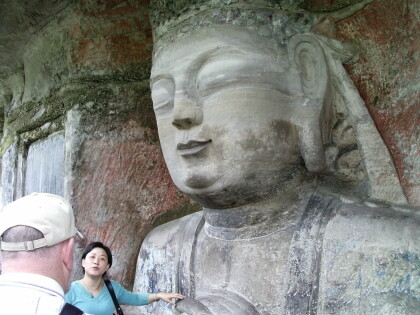
DERTOUR tour guide Shimbo in treasury mountain
The drive from Chongqing there (about 80 km) took our bus about 3 hours, and led by a typical Chinese landscape with a lot of rice cultivation. The cave sculptures belong since 1999 a UNESCO World Heritage Site. Our DERTOUR tour guide led us Shimbo in German language by the interesting complex. Particularly impressive were the scenes of the " Last Judgment ". After lunch we drove back to Chongqing, where we arrived about 18 clock on our cruise ship Blue Whale. Since the restaurant was already closed on the ship, we bought the usual fruit and drinks in a large supermarket above the deposition site ( "last supermarket on the Yangtze").
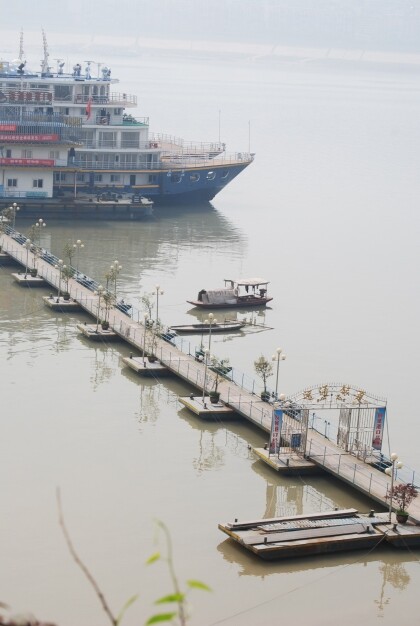
Dock on the Yangtze
The catchment area of the Yangtze River stretches over an area of approximately 2 million square kilometers with hot, humid summers (with ample rainfall) and cold, dry winters. The headwaters of the Yangtze River are fed by 5,000 m high Glestschern of Tangula in the northeast of the Tibetan Plateau. At the mouth of the Min River ( in Yibin - to get the Yangtze River is navigable ) begins the middle reaches of the Yangtze River. Between Fengjie and Yichang it flows through the impressive Three Gorges of the central Chinese mountain country. From the dam in Yichang Gezhouba at the lower reaches of the Yangtze River begins. He passes through the cities of Wuhan, Wuhu and Nanjing. After more than 6300 km of the Yangtze River flows north of Shanghai in a 200 km wide estuary in the East China Sea.
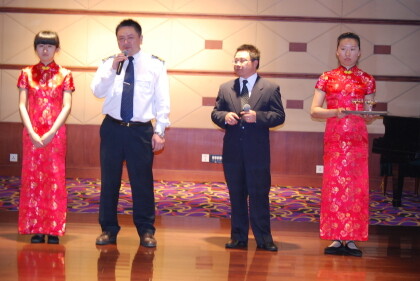
Welcome by the captain of the "Blue Whale"
21.30 clock put our ship from Chongqing. At night we reached Fengdu. On Tuesday morning, 19.4.2011, we visited 8.30 bis 10.30 clock very interesting ghost town. In 171 km distance from the start of our Yangtze Cruise, Chongqing lies the small town of Fengdu, which is notorious since the Han period as " the entrance to Hades ." Across the street is the impressive "ghost town" on the 288 m high mountain temple Ming Shan. Below the Temple Mount anchored our cruise ship "Blue Whale". The Daoist Temple and newconstructed figures (after the destruction during the Cultural Revolution), one could also better than " Devil's Town " call , because this shows what happens to one in ten Chinese hells.
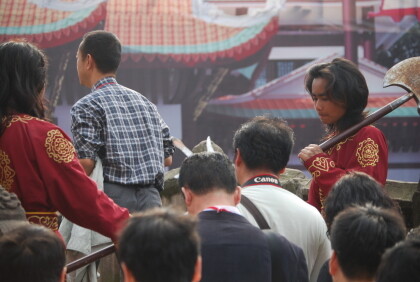
Visitors to the ghost town
According to the Chinese one must await the judgment of the Court of hell and then atone in terrible tortures for his sins. After that you will eventually reborn - depending on past life only as a dog or a worm. The origin of these spirits or hell city dates back to the Han Dynasty 2,000 years ago, when two officers, Mr. Yin and Mr. Wang, withdrew from the government service and here began the life of Taoist hermits.
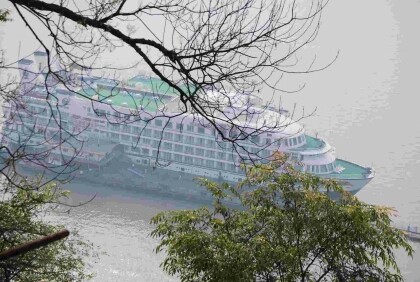
Cruise ship " Blue Whale " on the Yangtze
Our cruise ship Blue Whale had created on the opposite side of the city Fengdu 800,000 inhabitants). We were in the first Section with electric carts transported upwards. From there, the walk went on and after 400 steps , we reached the "ghost town", which is located on the 288 m high mountain temple Ming Shan. On this trip, which lasted about 2 hours, accompanied us to the ship photographer who was doing a DVD movie and shot pictures.
At 11 clock we took off and arrived at 16 clock in Shiboazai. There could - if desired - the "Stone Treasure Pagoda" be visited. We did not participate. The journey took around 19 clock continues to Fengjie, where we anchored on Wednesday, 20.4.2011 from 3 clock. There Qutang Gorge began (8 km long, 15 min drive-through) in which we entered against 10 clock. At 12 clock we came to our next landing Wushan.
In conjunction with the Three Gorges Staudammm the city Wushan was newly built. There lay on most cruise ships and passengers are switching to smaller vessels, with which the Daning - River (Daning He) is traversed. He was a tributary of the Yangtze River, whose lower reaches are but disappeared by the dam. It happened on the way " Three Little Gorges ". In the middle gorge ( " Misty Gorge " ) should be on a rock face on the left side in a low, inaccessible cave a wooden coffin see (note: despite evidence failed us). This burial custom is attributed to the proto - Chinese Ba culture. Until the Ming period was maintained in the secluded valleys.
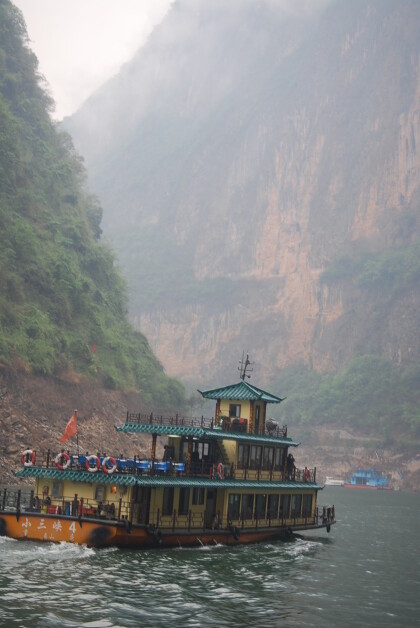
On the Daning River
We were up on a smaller ship, with which we sailed the adventurous canyon of the Daning River. Although it was raining - but the creation of existing life jackets were not required. We passed a very exciting and impressive landscape. Supposedly should be hanging in the cliff walls coffins with the dead. We could not locate this though. The helmsman (Captain) invited me to come into the closed cab and operate the ship's rudder. It worked quite well. We drove about 2 hours upstream, placed anywhere and were after 4 hours back to our cruise ship.
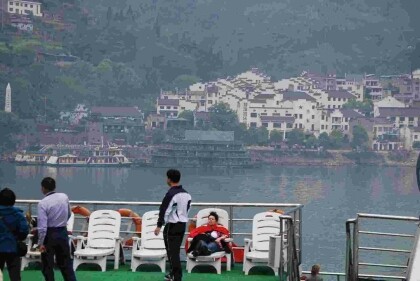
Cruise ship " Blue Whale"
At 17 clock went by M. S. Blue Whale through the Wu Gorge. It ends in Badung. In the early morning of Thursday, 21.4.2011, we reached at 1.30 clock the first lock of the Three Gorges Dam. At 6 clock we had passed all 5 locks. Overall, we had covered a distance of 660 km. There was then a short section to Yichang, where we continue flew to Shanghai. The entire trip was very impressive and the service excellent.
The dam is located in the Xiling Gorge (the 3rd) at the city Sandouping, Circle Yichang, Hubei Province, about 40 km from the first dam Gezhouba (built 1986) in the Yangtze River and 660 km from Chongqing away. The length of the dam is 2309 m, the height of 185 m above sea level, the width of the dam crest 18 m and width of the foot dam 124 m. The maximum water level is 175 m above sea and the water gradient 113 m (maximum). The entire reservoir has a length of 650 km, and the average width is 1.1 km. The storage capacity is 39.3 billion cubic meters - of which the share for flood prevention is 22.5 billion cubic meters. The suppliers of the 32 generators: 6 Siemens, 8 of GEC Alsthom, 18 local). The performance of individual generators is 700 MW. A total of 104 250 000 000 KW of electricity is generated annually.
There are 5 lock chambers of 280 m long, 34 m wide, 5 m depth. The size of the currently built hydraulic lift is 120 m long, 18 m wide and 3.5 m depth. The entire construction took 17 years: 1993 to 1997, the first phase, 1997-2003, the second phase, from 2003 to 2009, the third phase. In the official description of the Chinese side, the total cost after the recent bill 180 billion yuan (20 billion euros) are called (were planned 200 billion yuan - 22.2 billion euros). Overall, 1.4 million people had to be resettled (13 cities, 140 small towns, 1352 villages, 657 factories, 1,600 schools and 800 historic sites).
After we passed the 5 locks of the Three Gorges Dam at 6 clock, we had until around 8:30 clock on our cruise ship MS Blue Whale wait until we could go in the small town of Sandouping ashore. There was waiting a bus with a local tour guide (but only spoke English) to us and we drove to the guarded area of the dam.
We were only allowed to enter this area after our bags and backpacks had been X-rayed. We visited the large dam and the boat lift for smaller vessels to be completed in 2014. After that we saw in a hall the model of the entire project.
From a small hill we had an excellent overview what the locks, which were covered with several ships. At 11 clock we came back to our ship. We then drove through the third and last gorge, the Xiling Gorge. Around 13.30 clock, we disembarked (40 km away from the dam) at Yichang.
In the footsteps of Marco Polo and the turbulent Shanghai Under time pressure we arrived at our bus at the airport in Yichang. Then there were also problems with the boarding passes, because there were too few have been printed. Our tour guide Chang almost desperate. My wife finally got her boarding pass after she presented her passport and her name has been transmitted. As might be expected, we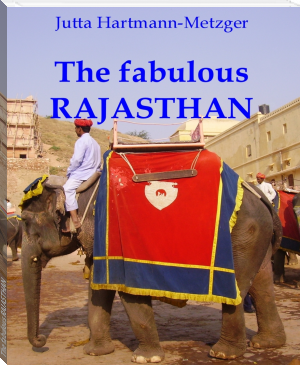




Comments (0)